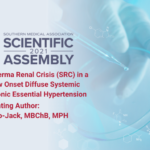Abstract | November 8, 2021
A Case of Scleroderma Renal Crisis (SRC) in a patient with New Onset Diffuse Systemic Sclerosis and Chronic Essential Hypertension
Learning Objectives
- Maintain a high index of suspicion in patients with established Essential hypertension who also have Scleroderma.
- Demonstrate the need for ACE-Is as first line SRC therapy. There is no empirical role for ACE-Inhibitor use in Scleroderma, however it is recommended that patients with hypertension should be started on ACE-Is or ARBs if they are at high-risk for SRC.
- Be made aware of the need for urgent intervention given poor disease prognosis if untreated.
Introduction: Although rare, SRC is a life-threatening kidney manifestation seen mainly in patients with diffuse rather than limited scleroderma. Predisposing factors include early-stage disease and rapid progression of skin changes. The hallmark of scleroderma renal crisis is the acuity of findings; Acute Kidney injury (AKI) without appreciable history of kidney disease, acute onset of malignant hypertension with complications such as flash pulmonary edema and/or hypertensive encephalopathy. Pathophysiology shows overexpression of Endothelin-1 with potent renovascular vasoconstriction, resulting in severe renal hypoperfusion. ACE inhibitors are the therapy of choice and steroids should be avoided. A good index of suspicion is necessary to diagnose SRC in patients who have baseline hypertensive disease as prognosis of SRC is poor and if left untreated, may lead to early initiation of hemodialysis, need for renal transplant, and/or death. Here, we present a case of Scleroderma Renal Crisis in a patient with established Hypertension.
Case report: A 60-year-old female presented with 1 week of progressive shortness of breath, cough, orthopnea and weight gain. Three weeks prior, she was managed for similar symptoms as well as new-onset AKI. Medical history includes Essential Hypertension on Atenolol monotherapy and a recent diagnosis of Diffuse Scleroderma and Pulmonary Hypertension 6 months before presentation.
At presentation, BP was 214/101, SpO2 89%. Serum Creatinine was 1.5 with a baseline of 0.6 a month prior. Chest X-ray showed pulmonary edema.
Final/Working diagnosis: An initial diagnosis of Hypertensive Emergency with Flash Pulmonary Edema and AKI was made. However, due to patient’s Scleroderma history and recent clinical manifestations, SRC was suspected.
Management and Outcome: Patient was managed with Supplemental O2, IV anti-hypertensive medications and diuretics however BP remained elevated. With suspicion of SRC, Captopril was initiated and up-titrated with good results. Patient was discharged on low-dose Lisinopril and advised to follow-up with her Rheumatologist.

